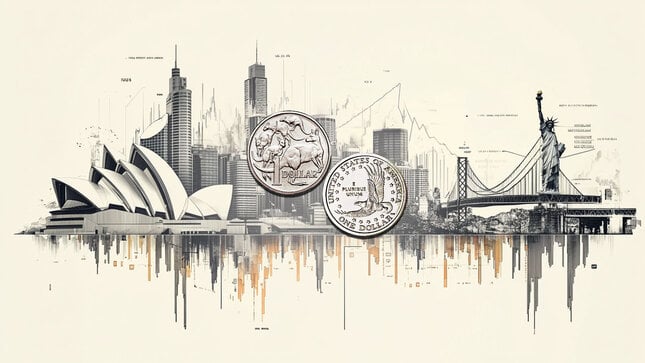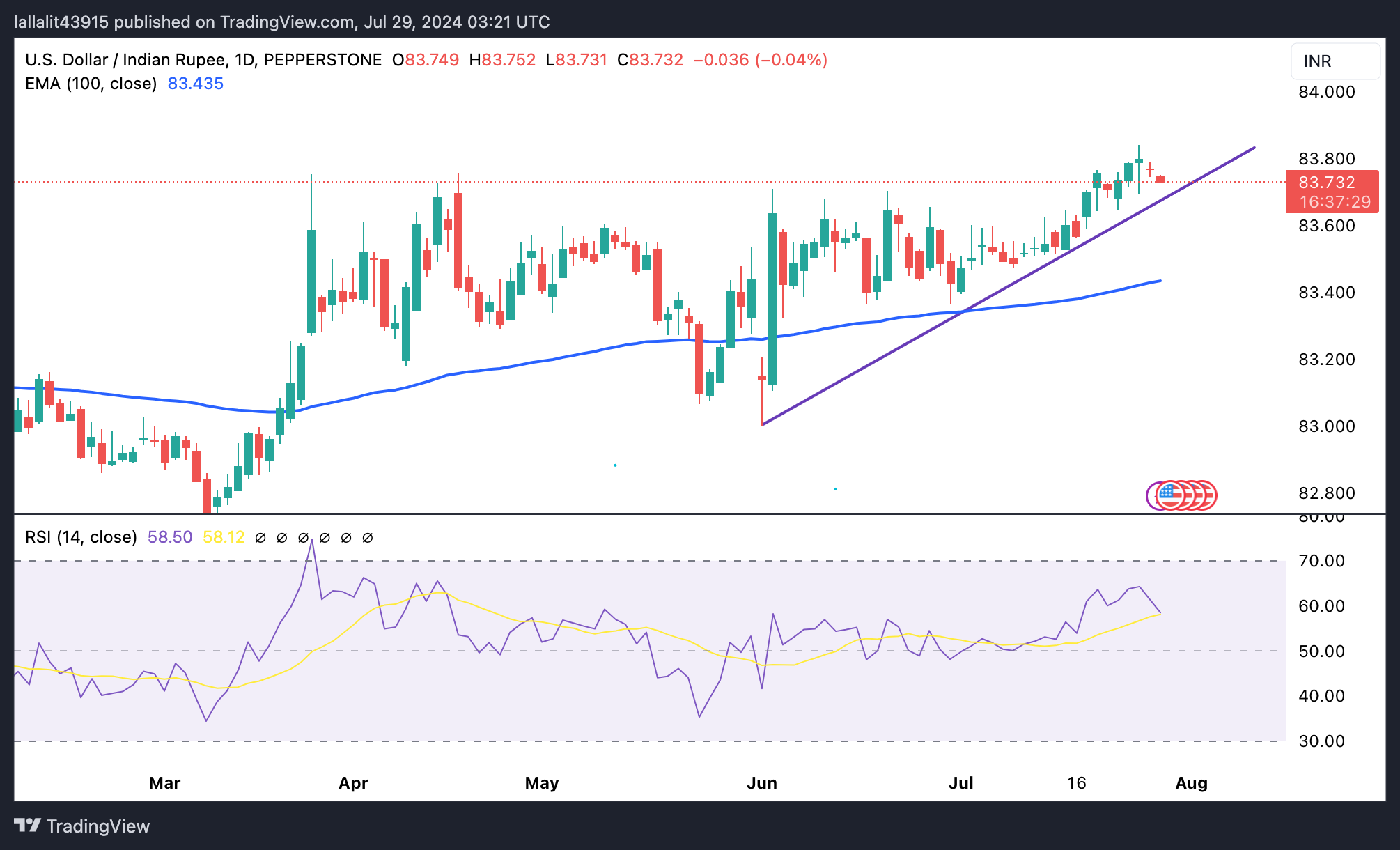- The Indian Rupee trades flat despite the weaker Greenback in Monday’s Asian session.
- Renewed US Dollar demand, India’s foreign outflows and geopolitical risks might weigh on the INR.
- The Fed is widely expected to keep rates unchanged at its July 30-31 meeting.
The Indian Rupee (INR) trades sideways on Monday despite the softer US Dollar (USD). The upside for INR is likely to be limited after reaching an all-time low last week, pressured by continuous USD demand from oil importers and India’s outflows from local equities. Additionally, the rising geopolitical risks in the Middle East might boost the safe-haven Greenback ahead of the key US events this week. On the other hand, traders expect the Reserve Bank of India (RBI) to continue intervening in the foreign exchange (FX) market to limit volatility. This, in turn, might cap the pair’s upside in the near term.
The US Federal Reserve (Fed) Interest Rate Decision will take centre stage on Wednesday, with no change in rate expected. Investors will take cues from Fed Chair Jerome Powell's remarks to gauge the future path of US interest rates. Any dovish comments from the Fed officials or hope of a rate cut by the Fed in September might drag the Greenback lower. Later this week, the attention will shift to the Indian HSBC Manufacturing PMI on Thursday and the US Nonfarm Payrolls for July on Friday.
Daily Digest Market Movers: Indian Rupee flat lines despite multiple headwinds
- The RBI was likely selling US Dollars on Monday to support the local currency, which was pinned near its all-time low, five traders told Reuters.
- The Dollar-Rupee pair is likely to move higher steadily with support "shifting upward to 83.45 while getting resisted at 83.85," said Dilip Parmar, a foreign exchange research analyst at HDFC Securities.
- Foreign investors have net sold about $1 billion worth of Indian equities since July 23, when the Indian government proposed to raise taxes on profits from equity investments and on equity derivative transactions.
- The Golan Heights attack on Saturday has raised worries about a war between Israel and Hezbollah. Israel accuses Hezbollah of carrying out the strike on a football pitch, which killed at least 12 people, including children, and it has promised to react. However, Hezbollah denies being involved in the attack, per the BBC.
- The US Personal Consumption Expenditures (PCE) Price Index rose rose 2.5% on a yearly basis in June, compared to 2.6% in May, in line with the market consensus. On a monthly basis, the PCE Price Index increased 0.1% after staying unchanged in May.
- The US Core PCE inflation, which excludes volatile food and energy prices, climbed to 2.6% in the same period, matching May's increase and coming in above the estimation of 2.5% The core PCE Price Index increased 0.2% MoM in June, compared to 0.1% in May.
- The University of Michigan Consumer Sentiment Index jumped to 66.4 in July, better than the estimation and the previous reading of 66.
Technical analysis: Indian Rupee’s bearish picture remains intact
Indian Rupee trades on a flat note on the day. The USD/INR pair keeps the bullish vibe unchanged as the chart shows an uptrend line, while the price holds above the key 100-day Exponential Moving Average (EMA) on the daily chart. The 14-day Relative Strength Index (RSI) stands above the midline near 58.90, suggesting the long-term trend appears to be bullish.
Bullish candlesticks above the all-time high of 83.85 could draw in enough buyers to push USD/INR up to the 84.00 psychological level.
The initial support level could be found at the uptrend line around 83.70. If bearish momentum continues, look for further downside towards 83.51, a low of July 12. The next potential support level is seen at 83.44, the 100-day EMA.
US Dollar price this week
The table below shows the percentage change of US Dollar (USD) against listed major currencies this week. US Dollar was the weakest against the Japanese Yen.
| USD | EUR | GBP | CAD | AUD | JPY | NZD | CHF | |
| USD | -0.04% | 0.00% | -0.04% | -0.03% | -0.50% | -0.05% | -0.10% | |
| EUR | 0.04% | 0.05% | 0.00% | 0.02% | -0.43% | 0.00% | -0.07% | |
| GBP | 0.00% | -0.04% | -0.04% | -0.01% | -0.46% | -0.04% | -0.10% | |
| CAD | 0.05% | -0.02% | 0.01% | 0.02% | -0.43% | 0.00% | -0.05% | |
| AUD | 0.00% | -0.01% | 0.02% | -0.01% | -0.45% | -0.03% | -0.07% | |
| JPY | 0.49% | 0.42% | 0.45% | 0.43% | 0.45% | 0.41% | 0.37% | |
| NZD | 0.05% | 0.00% | 0.04% | -0.02% | 0.02% | -0.42% | -0.05% | |
| CHF | 0.11% | 0.07% | 0.11% | 0.07% | 0.09% | -0.39% | 0.07% |
The heat map shows percentage changes of major currencies against each other. The base currency is picked from the left column, while the quote currency is picked from the top row. For example, if you pick the Euro from the left column and move along the horizontal line to the Japanese Yen, the percentage change displayed in the box will represent EUR (base)/JPY (quote).
Indian economy FAQs
The Indian economy has averaged a growth rate of 6.13% between 2006 and 2023, which makes it one of the fastest growing in the world. India’s high growth has attracted a lot of foreign investment. This includes Foreign Direct Investment (FDI) into physical projects and Foreign Indirect Investment (FII) by foreign funds into Indian financial markets. The greater the level of investment, the higher the demand for the Rupee (INR). Fluctuations in Dollar-demand from Indian importers also impact INR.
India has to import a great deal of its Oil and gasoline so the price of Oil can have a direct impact on the Rupee. Oil is mostly traded in US Dollars (USD) on international markets so if the price of Oil rises, aggregate demand for USD increases and Indian importers have to sell more Rupees to meet that demand, which is depreciative for the Rupee.
Inflation has a complex effect on the Rupee. Ultimately it indicates an increase in money supply which reduces the Rupee’s overall value. Yet if it rises above the Reserve Bank of India’s (RBI) 4% target, the RBI will raise interest rates to bring it down by reducing credit. Higher interest rates, especially real rates (the difference between interest rates and inflation) strengthen the Rupee. They make India a more profitable place for international investors to park their money. A fall in inflation can be supportive of the Rupee. At the same time lower interest rates can have a depreciatory effect on the Rupee.
India has run a trade deficit for most of its recent history, indicating its imports outweigh its exports. Since the majority of international trade takes place in US Dollars, there are times – due to seasonal demand or order glut – where the high volume of imports leads to significant US Dollar- demand. During these periods the Rupee can weaken as it is heavily sold to meet the demand for Dollars. When markets experience increased volatility, the demand for US Dollars can also shoot up with a similarly negative effect on the Rupee.
Information on these pages contains forward-looking statements that involve risks and uncertainties. Markets and instruments profiled on this page are for informational purposes only and should not in any way come across as a recommendation to buy or sell in these assets. You should do your own thorough research before making any investment decisions. FXStreet does not in any way guarantee that this information is free from mistakes, errors, or material misstatements. It also does not guarantee that this information is of a timely nature. Investing in Open Markets involves a great deal of risk, including the loss of all or a portion of your investment, as well as emotional distress. All risks, losses and costs associated with investing, including total loss of principal, are your responsibility. The views and opinions expressed in this article are those of the authors and do not necessarily reflect the official policy or position of FXStreet nor its advertisers. The author will not be held responsible for information that is found at the end of links posted on this page.
If not otherwise explicitly mentioned in the body of the article, at the time of writing, the author has no position in any stock mentioned in this article and no business relationship with any company mentioned. The author has not received compensation for writing this article, other than from FXStreet.
FXStreet and the author do not provide personalized recommendations. The author makes no representations as to the accuracy, completeness, or suitability of this information. FXStreet and the author will not be liable for any errors, omissions or any losses, injuries or damages arising from this information and its display or use. Errors and omissions excepted.
The author and FXStreet are not registered investment advisors and nothing in this article is intended to be investment advice.
Recommended content
Editors’ Picks

AUD/USD: Further gains look likely above 0.6400
AUD/USD reversed Wednesday’s decline and rose modestly on Thursday, managing to reclaim the area beyond 0.6300 the figure against the backdrop of fresh downside pressure in the Greenback.

EUR/USD snaps losing streak, but market clouds continue to gather
EUR/USD caught a breather on Thursday, rising by four-tenths of one percent and snapping a six-day losing streak that saw Fiber shed 2% peak-to-trough.

Gold trades around $3,050, higher highs ahead
Relentless tariff jitters, coupled with renewed weakness in the US Dollar, have propelled gold prices back toward record territory—hovering just above $3,060 per troy ounce.

XRP yet to see gains despite Ripple's partnership with Chipper Cash
XRP failed to recover on Thursday, noting a 2% decline despite Ripple's latest partnership with mobile payment services provider Chipper Cash. The collaboration aims to support cross-border payments for Chipper Cash using Ripple Payments.

US: Trump's 'Liberation day' – What to expect?
Trump has so far enacted tariff changes that have lifted the trade-weighted average tariff rate on all US imports by around 5.5-6.0%-points. While re-rerouting of trade will decrease the effectiveness of tariffs over time, the current level is already close to the highest since the second world war.

The Best brokers to trade EUR/USD
SPONSORED Discover the top brokers for trading EUR/USD in 2025. Our list features brokers with competitive spreads, fast execution, and powerful platforms. Whether you're a beginner or an expert, find the right partner to navigate the dynamic Forex market.
